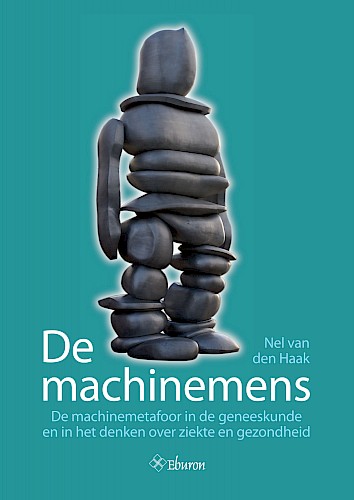De machinemens
De machinemetafoor in de geneeskunde en in het denken over ziekte en gezondheid
Nel van den Haak
— Reviewed by
Nel van den Haak, De Machinemens: De Machinemetafoor in de Geneeskunde en in het Denken over Ziekte en Gezondheid [The human machine: The machine metaphor in medicine and in thinking about illness and health]. Delft: Uitgeverij Eburon, 2013. 258 pp. (pb). €29.90. ISBN: 9789059727359.
De machinemens,by philosopher Nel van den Haak, is a history of philosophical thought on machine and mechanism in relation to people’s health, and how interpretations of ‘human as machine’ have affected scientific development in general and medicine in particular over the past four hundred years. The book focuses on the Netherlands and also pays attention to the historical development of medical education in the Netherlands. The philosophers that are most extensively discussed are René Descartes (a resident of the Netherlands for two decades), Herman Boerhaave (a doctor, philosopher, and reformer of medical education in the Netherlands), and Julien Offray de La Mettrie (a doctor and philosopher who studied with Boerhaave). Other important characters in the book are Leonardo Da Vinci, Sigmund Freud, Andreas Vesalius, and Helmuth Plessner. Plessner made contributions to philosophy of biology and to philosophy of anthropology.
The book’s primary audience is doctors and health care professionals and it does not require special knowledge about philosophy. The numerous headings and subheadings in the ten chapters and the index make it easy to look up philosophers’ thoughts on specific subjects, and to find particulars on the history of medicine as a science and as a profession in the Netherlands. The book is largely descriptive in nature with the exception that the author appears to hold a negative opinion of evidence-based medicine understood as exclusively rooted in clinical trials.
De machinemens demonstrates the incredible versatility and transformations of machine and mechanism as explanatory concepts through the ages. The machine metaphor has been present for a long time, but it was not always dominant in science and medicine. Furthermore, how a machine is conceptualized and what attributes are ascribed to it change over time. As the author narrates, in antiquity ‘machine’ mainly referred to instruments used in war or in the theatre – the deus ex machina – which let the Gods appear and disappear from the stage. Meanings associated with machine were ruse, stealth, and sophistication in one’s choice of instruments. According to the author, the concept of machine changed radically from the thirteenth to the seventeenth century, in parallel with the mechanization of worldviews. With the latter, Van den Haak means that machine and mechanism came to be associated with knowledge acquisition, transparency, and efficiency. The particular machine used to think about or explain illness and health also changed through the ages. For instance, the clock or watch was central in the thought of Descartes and La Mettrie, while Freud deployed the steam engine as a central exploratory device and metaphor.
The subtitle of the book suggests that metaphor is a central concept in the book, but the author does not introduce an explicit definition of metaphor, nor does she engage with the substantial body of literature on the concept. This is, I think, a missed opportunity. It is important in practice and education to be clear about when and in what manner ‘machine’ is used as a metaphor if only because different uses of metaphor may have different implications (for example, see Dewulf et al. 2009, for a discussion on the different implications of cognitive versus interactional approaches to metaphor).
Van den Haak limits herself to pointing out some common problems with the concept of metaphor. For instance, she argues that it is difficult to ascertain whether the philosophers discussed in De machinemens use ‘machine’ and ‘mechanism’ in a metaphorical sense, and, if so, whether all philosophers do so in the same way. The latter may in part explain why the book appears to be more about the use of the concepts of machine and mechanism through the ages irrespective of whether these concepts are truly and consistently deployed in a metaphorical fashion or not.
Interestingly, Van den Haak’s book is not entirely about the machine as a device to think and explain with but also about how philosophers’ ideas affected infrastructure and medical teaching practices. For instance, the emphasis thinkers such as Boerhaave and La Mettrie put on observation and empiricism contributed to the rise of medical theatres in which dead bodies were dissected in front of students and citizens, and facilitated the reintroduction of clinical rounds by Boerhaave in medical education.
Readers whose primary interest is in metaphor may be slightly disappointed. In contrast, readers interested in the history of medicine and medical education in the Netherlands may be pleasantly surprised by what the author has to share on this subject. The book may also be of interest to lecturers and researchers in the Netherlands who teach introductory courses on the history of ideas in medicine, the history of education of students and the public on medical issues, and the development of medicine as a science and as a practice.
About the author
Karen Mogendorff, PhD, is an anthropologist, communication scientist, and discursive psychologist. You can read more about her work here: http://karenmogendorff.weebly.com/publications.html
Reference
Dewulf, Art, Barbara Gray, Linda Putnam, Roy Lewicki, Noelle Aarts, Rene Bouwen, and Cees van Woerkum. 2009. ‘Disentangling Approaches to Framing in Conflict and Negotiation Research: A Metaparadigmatic Perspective’. Human Relations 62, no. 2: 155–93.
